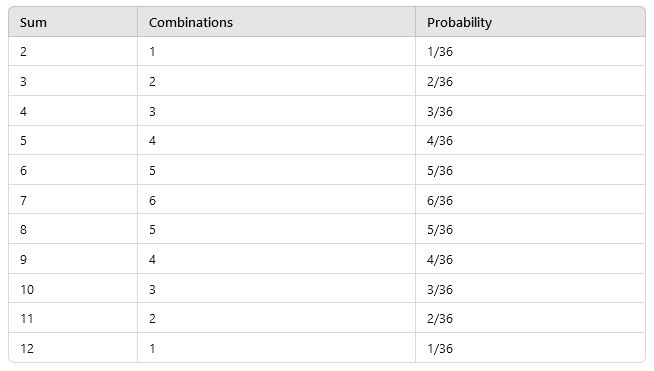Last updated on November 1, 2025
Backgammon uses two six-sided dice. Each die has faces numbered 1 through 6. When it’s your turn, you move your checkers based on the numbers you roll. You can split the dice between two checkers or combine them for one checker. For example, if you roll a 4 and a 5, you can move one checker 4 spaces and another 5 spaces, or move one checker a total of 9 spaces. Understanding how to calculate backgammon dice probabilities can help you plan your moves. Let’s break down how to calculate the chances of rolling certain numbers during the game.
Note: We are assuming that a “fair die”, “unbiased die”, or “unloaded die” is being used. These terms emphasise that all outcomes are equally likely, and the die is not altered or weighted to favour certain results. In tournament play, precision dice are required.
The basics of dice rolls
Each side of a fair die is equally likely to land face up, so the chance of rolling any single number is 1 out of 6 (or 1/6). When rolling two dice, the outcomes are independent, meaning the result of one die doesn’t affect the other. There are 36 possible combinations (6 sides on the first die × 6 sides on the second die). This makes the chance of any specific combination, like rolling a 2 on one die and a 3 on the other, 1/36 (Basic probability at Backgammon Galore).
Rolling at least one specific number
What are the odds of rolling at least one specific number (like a 2) with two dice? We count all the combinations where that number appears:
– The number can show up on the first die while the second die shows anything else (5 outcomes).
– It can show up on the second die while the first die shows something else (another 5 outcomes).
– It can show up on both dice at the same time (1 outcome).
That’s 11 outcomes in total. So, the chance of rolling at least one specific number (like a 2) is 11 out of 36 (11/36). This rule works for any number from 1 to 6 (Odds and Probabilities at GammonVillage).
Rolling a specific sum
If you’re looking for the chance of rolling a particular total (the sum of two dice), it’s a bit more complex. Each total has a different number of combinations. For example:
– To roll a 4, you can get (1, 3), (2, 2), or (3, 1), a total of 3 combinations.
– To roll an 11, you can get (5, 6) or (6, 5), a total of 2 combinations.
Here’s the full breakdown of probabilities for rolling each sum:
Combining probabilities for backgammon
In backgammon, you often want to know the chances of rolling either:
1. At least one specific number, or
2. A specific sum.
These events don’t overlap, so you can add their probabilities. For example:
– The chance of rolling at least one 6 is 11/36.
– The chance of rolling a sum of 6 is 5/36.
Add these together: 11/36 + 5/36 = 16/36. So, the chance of rolling either is 16/36.
You can calculate similar probabilities for any other number or sum you need (Backgammon probabilities at Backgammon365).
Summary
By understanding how to calculate backgammon dice probabilities, you can predict likely outcomes in backgammon and make better moves. Whether you’re calculating the odds of a specific sum or looking for at least one number, these simple steps will guide you. Practice a few scenarios, and you will very quickly see the benefits.
Related content
Dice at Wikipedia.

Maths was never my strong point at school, but this useful. Thanks